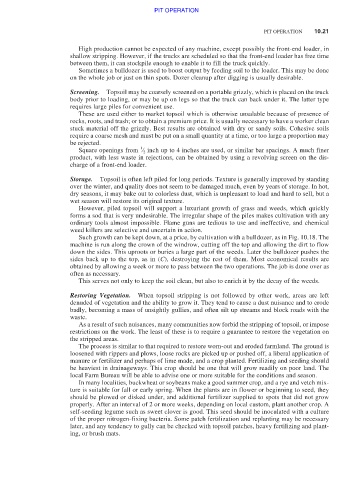Page 515 - Moving the Earth_ The Workbook of Excavation
P. 515
PIT OPERATION
PIT OPERATION 10.21
High production cannot be expected of any machine, except possibly the front-end loader, in
shallow stripping. However, if the trucks are scheduled so that the front-end loader has free time
between them, it can stockpile enough to enable it to fill the truck quickly.
Sometimes a bulldozer is used to boost output by feeding soil to the loader. This may be done
on the whole job or just on thin spots. Dozer cleanup after digging is usually desirable.
Screening. Topsoil may be coarsely screened on a portable grizzly, which is placed on the truck
body prior to loading, or may be up on legs so that the truck can back under it. The latter type
requires large piles for convenient use.
These are used either to market topsoil which is otherwise unsalable because of presence of
rocks, roots, and trash; or to obtain a premium price. It is usually necessary to have a worker clean
stuck material off the grizzly. Best results are obtained with dry or sandy soils. Cohesive soils
require a coarse mesh and must be put on a small quantity at a time, or too large a proportion may
be rejected.
1
Square openings from ⁄ 2 inch up to 4 inches are used, or similar bar spacings. A much finer
product, with less waste in rejections, can be obtained by using a revolving screen on the dis-
charge of a front-end loader.
Storage. Topsoil is often left piled for long periods. Texture is generally improved by standing
over the winter, and quality does not seem to be damaged much, even by years of storage. In hot,
dry seasons, it may bake out to colorless dust, which is unpleasant to load and hard to sell, but a
wet season will restore its original texture.
However, piled topsoil will support a luxuriant growth of grass and weeds, which quickly
forms a sod that is very undesirable. The irregular shape of the piles makes cultivation with any
ordinary tools almost impossible. Flame guns are tedious to use and ineffective, and chemical
weed killers are selective and uncertain in action.
Such growth can be kept down, at a price, by cultivation with a bulldozer, as in Fig. 10.18. The
machine is run along the crown of the windrow, cutting off the top and allowing the dirt to flow
down the sides. This uproots or buries a large part of the weeds. Later the bulldozer pushes the
sides back up to the top, as in (C), destroying the rest of them. Most economical results are
obtained by allowing a week or more to pass between the two operations. The job is done over as
often as necessary.
This serves not only to keep the soil clean, but also to enrich it by the decay of the weeds.
Restoring Vegetation. When topsoil stripping is not followed by other work, areas are left
denuded of vegetation and the ability to grow it. They tend to cause a dust nuisance and to erode
badly, becoming a mass of unsightly gullies, and often silt up streams and block roads with the
waste.
As a result of such nuisances, many communities now forbid the stripping of topsoil, or impose
restrictions on the work. The least of these is to require a guarantee to restore the vegetation on
the stripped areas.
The process is similar to that required to restore worn-out and eroded farmland. The ground is
loosened with rippers and plows, loose rocks are picked up or pushed off, a liberal application of
manure or fertilizer and perhaps of lime made, and a crop planted. Fertilizing and seeding should
be heaviest in drainageways. This crop should be one that will grow readily on poor land. The
local Farm Bureau will be able to advise one or more suitable for the conditions and season.
In many localities, buckwheat or soybeans make a good summer crop, and a rye and vetch mix-
ture is suitable for fall or early spring. When the plants are in flower or beginning to seed, they
should be plowed or disked under, and additional fertilizer supplied to spots that did not grow
properly. After an interval of 2 or more weeks, depending on local custom, plant another crop. A
self-seeding legume such as sweet clover is good. This seed should be inoculated with a culture
of the proper nitrogen-fixing bacteria. Some patch fertilization and replanting may be necessary
later, and any tendency to gully can be checked with topsoil patches, heavy fertilizing and plant-
ing, or brush mats.

